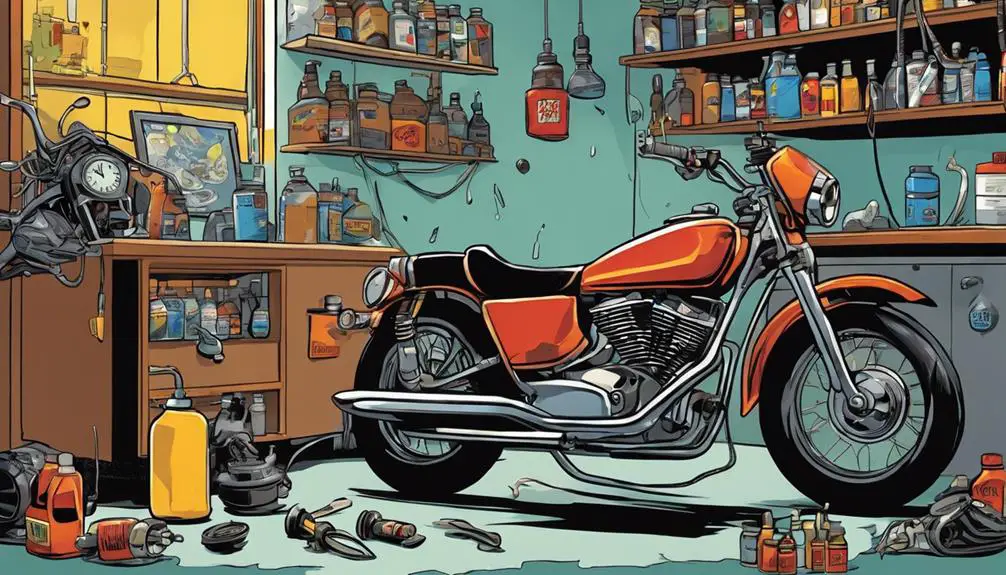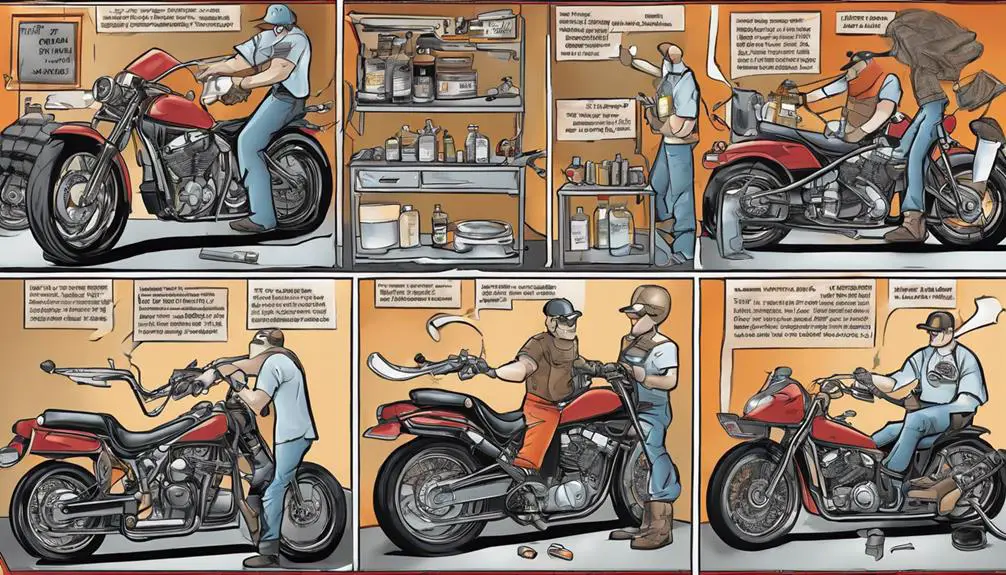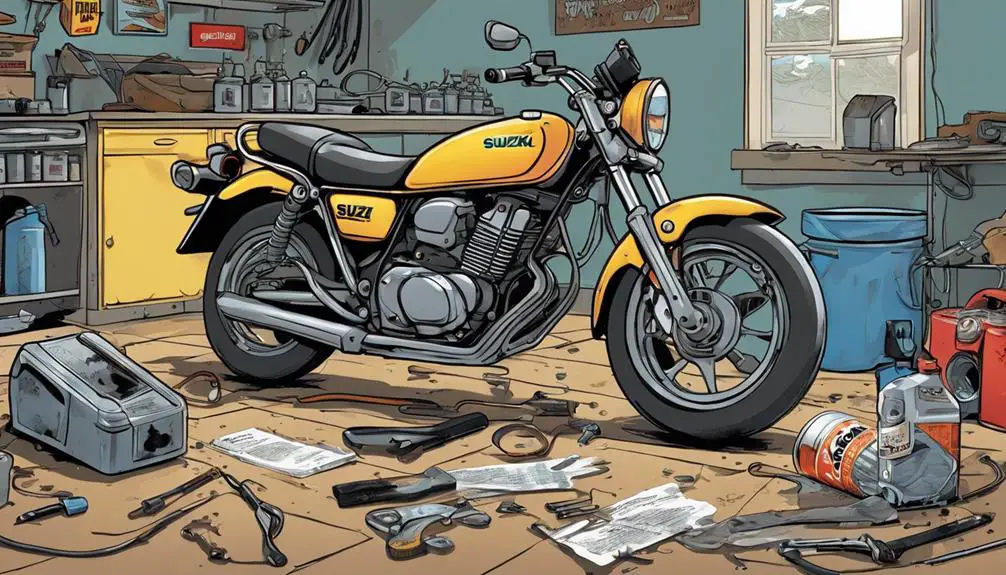Changing the oil, maintaining the engine, and guaranteeing a smooth ride are all essential for your motorcycle's longevity. You might think it's just about draining old oil and adding new, but there's a precise process that can make all the difference. Understanding the necessary tools and steps, as well as avoiding common mistakes, can keep your bike running efficiently. So, what are the critical steps you need to follow to guarantee a proper oil change?
Quick Takeaways
- Warm up the motorcycle to thin the oil for easier drainage before starting the oil change process.
- Use an adjustable wrench or socket set to remove the oil drain plug and allow complete drainage into a drain pan.
- Replace the old oil filter with a new one, applying fresh oil to the gasket to ensure a proper seal.
- Pour the correct type and amount of new oil into the engine, following the owner's manual recommendations.
Importance of Regular Oil Changes

Regular oil changes are essential for keeping your motorcycle's engine running smoothly and extending its lifespan. When you change the oil regularly, you're ensuring that the engine remains lubricated and free from harmful contaminants. Fresh oil helps reduce friction between moving parts, which can prevent overheating and wear. You want your ride to be reliable and powerful, and regular oil changes are a key part of that.
Think of oil as the lifeblood of your motorcycle. Without it, you're risking serious damage that could lead to costly repairs or, worse, leave you stranded. By staying on top of oil changes, you're not just taking care of your bike; you're embracing the freedom that comes with a well-maintained machine.
Moreover, regular oil changes can enhance your motorcycle's performance, allowing you to feel the thrill of the open road without worry. It's about more than just mechanics; it's about the connection between you and your bike.
You deserve that smooth, exhilarating ride. So, prioritize those oil changes, and enjoy the liberation that comes from knowing you're taking care of your motorcycle like a true enthusiast.
Tools and Materials Needed
To successfully complete an oil change on your motorcycle, you'll need a few essential tools and materials at your disposal.
First, grab an adjustable wrench or socket set; you'll use these for removing the drain plug and the oil filter. A funnel is vital for pouring new oil without creating a mess, so don't forget that.
Next, stock up on the right type of oil and a new oil filter specific to your bike's make and model. Check your owner's manual for the exact specifications. You'll also want a drain pan to catch the old oil, preventing any spills that could harm the environment.
Additionally, have some rags or paper towels handy for cleaning up any spills or wiping your hands. Finally, consider wearing gloves to protect your skin from oil and dirt.
With these tools and materials in hand, you're ready to embrace the freedom that comes with maintaining your motorcycle. You'll not only enhance its performance but also deepen your connection with this magnificent machine.
Step-by-Step Oil Change Process

Begin by warming up your motorcycle for a few minutes to thin the oil, making it easier to drain. Once it's warmed up, turn it off and let it sit for a moment to avoid burns.
Position your motorcycle on a stable surface and place a drain pan underneath the oil pan. Remove the oil drain plug and allow the old oil to flow into the pan completely.
While the oil drains, replace the oil filter. Use an oil filter wrench to loosen it, then twist it off by hand. Before installing the new filter, apply a bit of fresh oil to the rubber gasket on the new filter to guarantee a good seal. Screw it on hand-tight.
Once the old oil has completely drained, replace the drain plug and tighten it securely.
Now, pour in the new oil using a funnel. Check your owner's manual for the correct amount and type of oil. After you've filled it, start your motorcycle and let it run for a minute, then check for leaks.
Common Mistakes to Avoid
One of the most common mistakes you can make during an oil change is forgetting to check the oil type and amount specified in your owner's manual. Using the wrong oil can lead to engine problems that undermine your freedom on the road. Always confirm the viscosity and specifications before you start.
Another mistake is skipping the oil filter replacement. The filter traps contaminants, and if you don't change it, dirty oil can circulate through your engine, limiting performance. Don't cut corners; invest in a quality filter to maintain that smooth ride.
Additionally, remember to give your engine a moment to cool down before you begin. Trying to change hot oil can lead to burns or spills. Wait until it's safely cool to the touch.
Lastly, don't forget to dispose of the old oil properly. Pouring it down the drain isn't just irresponsible; it can hurt the environment. Look for local recycling centers or oil change shops that will take it off your hands.
Maintenance Tips for Suzuki Motorcycles

Regular maintenance is vital for keeping your Suzuki motorcycle running smoothly and extending its lifespan. By staying proactive, you'll enjoy every ride without worry.
Here are three important maintenance tips to keep your bike liberated and free:
- Check and Change Oil Regularly: Verify you're using the right oil for your Suzuki. Change it according to the manufacturer's recommendations to keep the engine humming and reduce wear.
- Inspect Tires and Brakes: Your tires are your lifeline on the road. Regularly check their pressure and tread. Don't forget to inspect your brakes—replace pads when they're worn to maintain control and safety.
- Clean and Lubricate the Chain: A well-lubed chain not only enhances performance but also prevents premature wear. Clean it regularly and apply appropriate lubricant for a smooth ride.
Common Questions
How Often Should I Change the Oil in My Motorcycle?
You should change the oil in your motorcycle every 3,000 to 5,000 miles, or at least once a year.
However, if you ride hard or in harsh conditions, consider changing it more often.
Keep an eye on your oil's color and consistency; if it looks dark or gritty, it's time for a change.
Regular oil changes not only keep your bike running smoothly but also give you the freedom to ride without worry.
Can I Use Car Oil for My Motorcycle?
You might think using car oil in your motorcycle is a clever shortcut, but it's risky.
Motorcycle engines operate differently, needing specific additives for peak performance. Car oil can lack those essential elements, potentially harming your engine.
If you want your ride to feel free and powerful, stick with oil designed for motorcycles. It'll keep your engine purring smoothly and guarantee you've got the liberation of the open road without the worry.
What Is the Best Oil Type for My Specific Motorcycle Model?
To find the best oil type for your specific motorcycle model, check your owner's manual first. It'll guide you on the recommended viscosity and specifications.
Generally, synthetic oils offer superior protection and performance, especially for high-performance bikes.
If you're feeling adventurous, consider oils designed for your bike's engine type—whether it's a cruiser, sport, or touring model.
Ultimately, choosing the right oil empowers your ride and keeps your engine running smoothly.
Is It Safe to Change Oil in Cold Weather?
Changing oil in cold weather can be safe, but it's not ideal. Cold temperatures can thicken oil, making it harder to drain and potentially leaving contaminants behind.
If you've got no choice, just guarantee your bike's engine warms up slightly before you start. This'll help the oil flow better.
Remember to wear gloves and keep yourself warm while you work, embracing the freedom of maintaining your ride even in chilly conditions!
How Do I Dispose of Used Motorcycle Oil Properly?
When it comes to disposing of used motorcycle oil, don't dump it down the drain!
Instead, deliver it to a designated disposal site or recycling center. Many auto shops and recycling facilities accept oil, making it easy to guarantee it's handled safely.
You're not just freeing your space; you're contributing to a cleaner environment.
Wrapping Up
To sum up, regularly changing your motorcycle oil not only boosts engine performance but can also extend its lifespan by up to 50%.
By following the steps outlined, you're ensuring a smoother ride and preventing costly repairs down the line.
Remember, a well-maintained bike is a happy bike!
So, keep up with your oil changes and enjoy the thrill of the open road with confidence.
It's not just maintenance; it's a commitment to your ride's longevity.